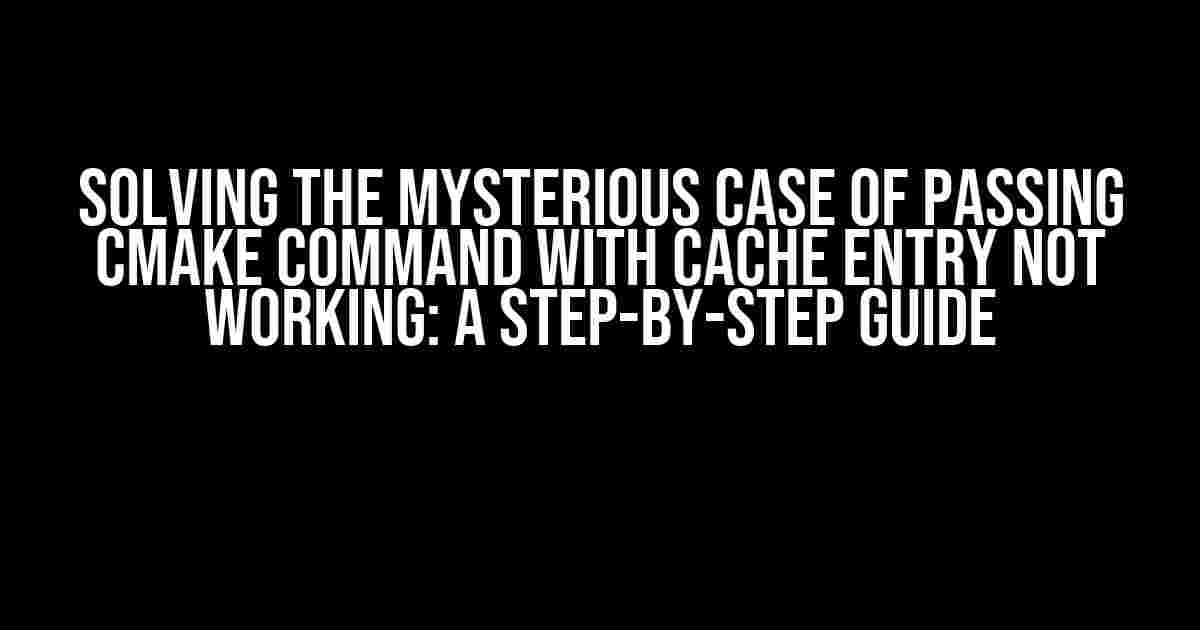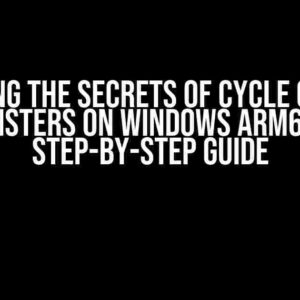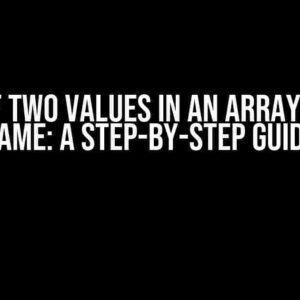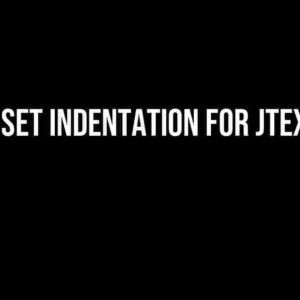Are you frustrated with CMake’s stubborn refusal to acknowledge your carefully crafted command line arguments? Do you find yourself stuck in an infinite loop of trying to pass a command with a cache entry, only to have it ignored? Fear not, dear developer, for we’re about to embark on a thrilling adventure to unravel the secrets of CMake’s behavior and uncover the hidden solutions to this perplexing problem.
Understanding the Problem: CMake’s Cache System
Before we dive into the fixing part, let’s take a step back and understand the root cause of the issue. CMake’s cache system is designed to store values that are generated during the configuration process. These values are stored in a file called `CMakeCache.txt` and are used to speed up the build process by reusing previously computed results.
However, this caching mechanism can sometimes lead to unexpected behavior, especially when trying to pass command line arguments with cache entries. It’s not uncommon for CMake to ignore these arguments or overwrite them with cached values, leaving you scratching your head and wondering what went wrong.
Scenario 1: Passing Command Line Arguments with `-D` Option
Lets say you want to pass a command line argument to CMake using the `-D` option. For example, you want to set the `CMAKE_BUILD_TYPE` variable to `Debug`:
cmake -DCMAKE_BUILD_TYPE=Debug ..
In most cases, this should work as expected. However, if you have a cached value for `CMAKE_BUILD_TYPE` from a previous run, CMake might ignore the new value and use the cached one instead.
Solution: Forced Override using `CACHE` Keyword
To force CMake to override the cached value, you can add the `CACHE` keyword to your command line argument:
cmake -DCMAKE_BUILD_TYPE:STRING=Debug ..
By adding `:STRING` to the argument, you’re telling CMake to treat the value as a string and override any cached value. This should ensure that your new value takes precedence.
Scenario 2: Passing Command Line Arguments with `-C` Option
Alternatively, you might want to pass a command line argument using the `-C` option, which tells CMake to load a pre-existing cache file. For example:
cmake -Cpath/to/cache/file ..
Again, this should work as expected, but what if you want to override a specific cache entry? Let’s say you want to change the `CMAKE_CXX_COMPILER` cache entry:
cmake -Cpath/to/cache/file -DCMAKE_CXX_COMPILER=g++ ..
In this case, CMake might still use the cached value for `CMAKE_CXX_COMPILER` instead of the new value.
Solution: Creating a New Cache File
To avoid this issue, you can create a new cache file using the `-CClear` option:
cmake -CClear -DCMAKE_CXX_COMPILER=g++ ..
This will clear the cache and create a new one with the updated value for `CMAKE_CXX_COMPILER`.
Scenario 3: Using `cmake` with `-i` Option
Another common scenario is using the `-i` option to specify a script file for CMake to execute. For example:
cmake -i script.cmake ..
What if you want to pass a command line argument to this script file? For example, you want to set a variable `FOO` to `bar`:
cmake -i script.cmake -DFOO=bar ..
Again, CMake might ignore the new value and use a cached one instead.
Solution: Using `set` Command in Script File
To avoid this issue, you can use the `set` command inside your script file to set the variable:
set(FOO "bar" CACHE STRING "Description")
This will ensure that the variable is set correctly and overrides any cached value.
Best Practices for Avoiding Cache-Related Issues
To minimize the risk of encountering cache-related issues, follow these best practices:
- Use the `–wipe-cache` option to clear the cache before running CMake:
cmake --wipe-cache ..
cmake -DCMAKE_BUILD_TYPE=Debug .. cmake -DCMAKE_BUILD_TYPE=Release ..
Instead, use separate cache files for each configuration:
cmake -DCMAKE_BUILD_TYPE=Debug -CDebugCache .. cmake -DCMAKE_BUILD_TYPE=Release -CReleaseCache ..
cmake -DCMAKE_BUILD_TYPE:STRING=Debug ..
rm CMakeCache.txt cmake ..
Conclusion
In conclusion, passing CMake command line arguments with cache entries can be a complex process, but by understanding the underlying cache system and using the right techniques, you can avoid common pitfalls and ensure that your build process runs smoothly. Remember to use the `CACHE` keyword, create new cache files when necessary, and follow best practices to minimize the risk of cache-related issues.
With these tips and tricks, you’ll be well on your way to taming the beast that is CMake’s cache system. Happy building!
| Scenario | Solution |
|---|---|
| Passing command line arguments with `-D` option | Use `CACHE` keyword to force override |
| Passing command line arguments with `-C` option | Create a new cache file using `-CClear` option |
| Using `cmake` with `-i` option | Use `set` command in script file to set variables |
- Clear the cache using `–wipe-cache` option
- Avoid using the same cache file for different build configurations
- Use `CACHE` keyword when passing command line arguments
- Verify that cache file is not corrupted or outdated
Remember, the key to success lies in understanding the cache system and using the right techniques to overcome common pitfalls.
Frequently Asked Question
Get the lowdown on the most common conundrums surrounding “Passing CMake command with cache entry not working and automatically ignored” and find the solutions you’ve been searching for!
Why do cache entries get automatically ignored when passing CMake commands?
When you pass a CMake command with a cache entry, it’s not actually ignored, but rather, CMake has a mechanism to prioritize user-provided values over cached ones. This means that if there’s an existing cache entry with a different value, it’ll take precedence over the one you’re trying to pass. To avoid this, you can use the FORCE option when setting the cache entry, like this: `-DCMAKE_FOO_BAR:STRING=VALUE`. This will overwrite any existing cache entry with the same name.
How do I troubleshoot issues with cache entries being ignored?
When troubleshooting, it’s essential to understand how CMake handles cache entries. Firstly, check your CMakeLists.txt file for any SET CACHE commands that might be overwriting your intended values. Next, examine the CMakeCache.txt file to see if the cache entries are being set as expected. Finally, try running CMake with the –debug-output option to get more verbose output, which can help you identify any issues.
Can I use environment variables to set cache entries?
Yes, you can use environment variables to set cache entries, but be aware that they might not take precedence over existing cache entries. To ensure that your environment variables are used, you can set the CMAKE_OVERRIDE_CACHE_VARIABLES variable to TRUE. However, keep in mind that this will override all cache entries, so use it with caution.
What’s the difference between SET CACHE and SET CACHE INTERNAL?
The main difference between SET CACHE and SET CACHE INTERNAL is that INTERNAL cache entries are not visible to the user, whereas regular cache entries are. INTERNAL cache entries are intended for internal use within the CMake script and should not be modified by the user. Regular cache entries, on the other hand, can be modified by the user and are intended for user-configurable settings.
Are there any best practices for managing cache entries in CMake?
Yes, there are several best practices for managing cache entries in CMake. Firstly, use meaningful and consistent names for your cache entries. Secondly, avoid using cache entries for internal implementation details, as they can be modified by the user. Finally, consider using option() instead of SET CACHE, as it provides more flexibility and user-friendly interaction.








